
|
Although it was reported so faint as 18.7 mag at the discovery, Michael Jager observed it on May 24 and found it was unexpectedly bright at around 13-14 mag. It brightened rapidly day by day after that, 12.1 mag on May 31, 11.6 mag on June 6, 9.8 mag on June 9 and 8.9 mag on June 10 (Juan Jose Gonzalez). Now it is very bright and large with a diameter of 6 arcmin. Moderately condensed, and easy to see. It wil pass the perihelion on July 5, and it will approach to the sun down to 0.54 AU. It will also come close by the earth. So it will be bright as 9 mag in the evening sky in June. In the Northern Hemisphere, it is observable until late June. In the Southern Hemisphere, it is observable between late June and early July, but locating low in the evening. It will fade out rapidly after July. It will appear at dawn again in August in the Southern Hemisphere, or in September in the Northern Hemisphere, when it will be 14-15 mag at that time. Because the absolute magnitude is faint as 13-14 mag, it can decline at the perihelion passage and become much fainter than expected after that. Giovanni Sostero and Akimasa Nakamura pointed out the central condensation got stronger rapidly within one week between late May and early June. In addition, recent brightening is abnormally rapid. They may be a sign of decline. After June 12, nucleus split was found by many persons including Giovanni Sostero. The secondary nucleus is clearly visible on their CCD images.
Date(TT) R.A. (2000) Decl. Delta r Elong. m1 Best Time(A, h)
June 11 8 43.52 54 59.2 0.639 0.773 49 9.7 20:59 (136, 31)
June 18 8 48.31 33 44.3 0.664 0.674 40 8.5 21:03 (118, 17)
|
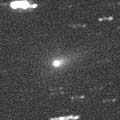
|
Although it was faint as 15.2 mag on Mar. 14 (Yuji Ohshima), it brightened in April, and finally it became bright enough to be visible visually, 12.3 mag on May 2 (Juan Jose Gonzalez). The comet keeps brightening, and now it is bright as 10.2 mag (June 6, Juan Jose Gonzalez). It keeps slightly fainter than this ephemeris. It keeps 10 mag until July. However, it keeps locating very low in the morning. The altitude keeps lower than 20 deg until September when it becomes fainter than 12 mag. It will be higher than 30 deg after October, when it will be already fainter than 13 mag.
Date(TT) R.A. (2000) Decl. Delta r Elong. m1 Best Time(A, h)
June 11 1 42.80 24 8.0 1.437 1.082 48 10.1 2:59 (254, 20)
June 18 2 16.17 23 48.3 1.427 1.059 47 10.1 2:58 (254, 19)
|
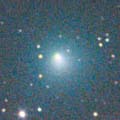
|
It was not visible visually still in February, fainter than 13.9 mag (Feb. 5, Seiichi Yoshida). However, it brightened very rapidly after that as expected, and reached to 10.6 mag at the end of April (Apr. 30, Shigeki Murakami). Then it keeps bright at 10 mag. Now it is 10.1 mag (June 6, Seiichi Yoshida). But, this is fainter than originally expected by 0.5 mag. Moderately condensed, and easy to see. It will keep 10 mag until the end of July in calculation. But it may become a naked-eye object due to the Deep Impact mission on July 4. Actually, this is the first experience in our history, and it is very uncertain what will happen on this comet. Observations are strongly encouraged.
Date(TT) R.A. (2000) Decl. Delta r Elong. m1 Best Time(A, h)
June 11 13 4.47 -0 27.4 0.790 1.526 114 10.1 20:59 ( 30, 50)
June 18 13 12.56 -3 9.0 0.818 1.516 111 10.1 21:03 ( 36, 45)
|

|
It was fantastic, so bright as 3.5 mag, so large as 30 arcmin, locating high overhead at its best time in early January. Then it has been getting fainter and smaller gradually, and 9.8 mag now (June 6, Seiichi Yoshida). The diameter is about 6 arcmin now. It became faint and small, however, it is still easy to see with a telescope. In the Northern Hemisphere, it keeps observable in good condition for a long time while the comet is bright enough visible visually until October when it becomes faint as 14 mag. Dennis Persyk detected the 27-arcmin long anti tail in late May. Now the earth latitude from the comet is small as about 10 degree, which supports to clarify the anti tail. The earth will pass across the orbital plane of the comet in late June, so maybe we can see the long anti tail for a while after this.
Date(TT) R.A. (2000) Decl. Delta r Elong. m1 Best Time(A, h)
June 11 12 54.51 40 55.7 2.058 2.322 91 10.2 20:59 (115, 72)
June 18 13 1.78 37 54.2 2.183 2.399 89 10.5 21:03 (105, 68)
|
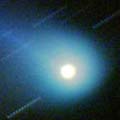
|
The brightness evolution had been slower than a typical comet since its discovery until the perihelion passage in early April. Although it kept bright as 8 mag from mid March to early May, it seems to start fading in mid May as expected, 8.4 mag on May 12 (Michael Mattiazzo). After this, it is not observable in the Northern Hemisphere until late September when it appears very low sky at dawn as 14 mag. It keeps lower than 20 deg high until early July even in the Southern Hemisphere. The comet will fade out rapidly after this, down to 12 mag until early July. However, no observations have been reported since mid May, so it is uncertain how the comet is fading now. Unusually strong non-gravitational parameters are revealed by the orbital calculation, but the reason has not been revealed yet.
Date(TT) R.A. (2000) Decl. Delta r Elong. m1 Best Time(A, h)
June 11 5 14.18 -36 40.1 1.690 1.469 59 10.3 2:59 (286,-53)
June 18 5 36.54 -35 38.3 1.817 1.561 59 10.7 2:58 (285,-52)
|

|
In January when it was visible in the Northern Hemisphere, it was an 11 mag small object. However, after it has gone to the southern sky, it reached to 8.0 mag, bright enough to be visible with binoculars, from March to April (Mar. 4 and Apr. 7, Alexandre Amorim). It must have started fading after mid April, however, it keeps bright as 8.9 mag still on May 12 (Michael Mattiazzo), brighter than this ephemeris by 1 mag. It had been very low even in the Southern Hemisphere for a while, but it will be higher again after this, and keeps observable while fading gradually. In the Northern Hemisphere, it is appearing again in the morning after the long blank. Only one observation was reported since mid April, so it is uncertain how the comet is fading now. Hirohisa Sato reported that it looks as bright as C/2005 K2 on SWAN images on June 9. This suggests it can be very bright still now, around 9 mag.
Date(TT) R.A. (2000) Decl. Delta r Elong. m1 Best Time(A, h)
June 11 2 1.00 -0 15.3 1.751 1.399 52 10.8 2:59 (272, 3)
June 18 2 0.60 2 45.0 1.744 1.486 58 11.0 2:58 (274, 10)
|
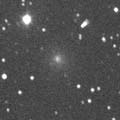
|
It was 18.5 mag in mid January, fainter than expected. It had been unobservable for a while after that. On May 12, when it was appearing in the morning low sky, it was observed as 14 mag (Michael Mattiazzo), confirmed that the comet had been brightening rapidly. It became visible visually on June 2 at 11.8 mag (Juan Jose Gonzalez). It has been brightening rapidly as expected, however, the current brightness is fainter than the previous appearance by 1 mag. In the Northern Hemisphere, it keeps observable for a long time after this, and is expected to reach to 9 mag from July to August. However, it unexpectedly brightened after the perihelion passage in its last appearance, and reached to the maximum brightness about 45 days after the perihelion passage. If it was due to the outburst, it may reach only to 11.5 mag at best in this return. In the Southern Hemisphere, it will be unobservable soon.
Date(TT) R.A. (2000) Decl. Delta r Elong. m1 Best Time(A, h)
June 11 1 40.44 39 55.5 1.709 1.282 48 11.7 2:59 (239, 28)
June 18 1 52.15 47 20.9 1.621 1.276 51 11.5 2:58 (232, 33)
|

|
Although it was only 19 mag in January, it has been brightening rapidly as expected since that, and it reached to 13.4 mag on May 20 (Mitsunori Tsumura). It finally became visible visually at 12.5 mag on June 7 (John Drummond). It is expected to keep visible as bright as 12-13 mag for a long time until September. In the previous return, it was 1.5 mag brighter than this ephemeris visually. So it can be around 11.0 mag visually at best in this return, too. The condition is good in the Southern Hemisphere. However, it locates very low in the Northern Hemisphere. Especially, it becomes lowest for the northern observers at 15 deg high until the end of June. So it will be easier to see visually in July and August.
Date(TT) R.A. (2000) Decl. Delta r Elong. m1 Best Time(A, h)
June 11 15 46.19 -39 53.7 0.680 1.656 154 12.5 22:26 ( 0, 15)
June 18 15 45.30 -38 58.0 0.674 1.635 150 12.4 21:58 ( 0, 16)
|

|
Not observable. It was bright as 7.5 mag in early January, easy to see with binoculars. However, it faded and got diffused rapidly in the evening sky since that. It faded to 10.7 mag on Mar. 15 visually (Alexandre Amorim), and 11.5 mag on Apr. 4 by CCD observation (Mitsunori Tsumura), then it became too low. Although it became faint very quickly, the fading pace was slower than usual. It will appear in the morning sky again in August. It may be still brighter than 14 mag at that time and visible visually.
Date(TT) R.A. (2000) Decl. Delta r Elong. m1 Best Time(A, h)
June 11 4 17.58 -4 3.8 4.346 3.512 30 13.0 2:59 (255,-27)
June 18 4 20.77 -3 55.4 4.381 3.588 34 13.2 2:58 (259,-22)
|
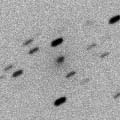
|
New periodic comet with a very short period of 4.4 years. Because it will pass very close by the earth down to 0.1 AU in June, it brightens rapidly. It will reach to 12-13 mag in the evening sky in mid June. However, it will be unobservable soon, too close to the Sun, in late June. It will appear in the morning again in late July at 15 mag, then it keeps observable while fading gradually. Although it was so faint as 17.5 mag in early May, it has brightening rapidly, 15.1 mag on May 26 and 14.5 mag on June 5 (Yusuke Ezaki). Michael Jager reported that the faint 1 arcmin coma was visible on May 27, then it became very bright as 13.5 mag, so large with a diameter of 5-6 arcmin on June 6. However, it was not visible visually, fainter than 13.7 mag (June 6, Seiichi Yoshida). Because it is very large and diffused, it will be hard to see it without clear sky. It brightened furthermore after that, 13.3 mag on June 13 (Yusuke Ezaki).
Date(TT) R.A. (2000) Decl. Delta r Elong. m1 Best Time(A, h)
June 11 13 18.37 8 21.5 0.161 1.090 113 13.9 20:59 ( 33, 60)
June 18 12 15.97 12 18.6 0.126 1.028 91 13.1 21:03 ( 68, 47)
|

|
Appearing at dawn. It was 14.2 mag on May 31 (Ken-ichi Kadota). Now it is not so bright, but not so faint., It had been always brighter than 13 mag and visible visually all through the season in 2004. In 2005, it is observable in very good condition, almost overhead in the Northern Hemisphere from summer to winter. It can be a good target of observaions if it becomes active as in 2004.
Date(TT) R.A. (2000) Decl. Delta r Elong. m1 Best Time(A, h)
June 11 1 53.44 20 16.8 6.388 5.746 47 13.7 2:59 (256, 16)
June 18 1 57.88 20 48.4 6.307 5.747 52 13.7 2:58 (259, 21)
|

|
It will reach to 9 mag in 2006 spring. In the Southern Hemisphere, it keeps observable until that. In the Northern Hemisphere, it is not observable until 2006 March, except it appears very low in the morning at 12 mag from late August to early September. After 2006 March, northern people can observe it for a long time while it is getting fainter. It had been brightening well as expected until 2005 March. After that, recent brightness is uncertain because it became unobservable in the Northern Hemisphere. It becomes extremely low even in the Southern Hemisphere until June.
Date(TT) R.A. (2000) Decl. Delta r Elong. m1 Best Time(A, h)
June 11 4 48.95 -15 48.7 4.118 3.396 39 13.9 2:59 (261,-40)
June 18 4 54.39 -16 26.7 4.017 3.329 41 13.7 2:58 (265,-36)
|

|
It had been lost for a long time. It was recovered in 1978. However, it was missed in two returns after that, and now it is lost again. Probably it is extremely faint normally, and it was observed only when it rarely brightened. It seems to locate around the predicted position, but it must be much fainter than this ephemeris. The condition in this return is bad. It keeps locating extremely low, so it will be impossible to recover. In the Southern Hemisphere, it locates 20 deg high in the morning from late May to early June. So if the comet unexpectedly brightens again, it may be recovered.
Date(TT) R.A. (2000) Decl. Delta r Elong. m1 Best Time(A, h)
June 11 2 52.71 13 1.2 1.381 0.812 35 13.9 2:59 (254, 0)
June 18 3 29.35 16 39.2 1.433 0.797 32 13.8 2:58 (250, 1)
|

|
It was 12.7 mag on May 4, visible visually still now (Seiichi Yoshida). It keeps 12.5-13.0 mag since November, however, now it is smaller and a bit fainter than last autmun while going away from the earth. It will be getting lower while fading after this, so it will be invisible visually soon. The altitude will be lower than 10 deg in late June.
Date(TT) R.A. (2000) Decl. Delta r Elong. m1 Best Time(A, h)
June 11 8 18.04 29 24.3 2.604 1.952 40 13.9 20:59 (115, 16)
June 18 8 37.04 28 20.2 2.665 1.975 38 14.1 21:03 (115, 13)
|

|
It was 16.4 mag at the discovery in March (Mar. 12, R. H. McNaught), but it brightened up to 15.1 mag on May 15 (Akimasa Nakamura). It is expected to be bright as 10 mag in early 2006. In the Southern Hemisphere, it keeps locating high until November while the comet is getting brighter gradually. In the Northern Hemisphere, it keeps locating very low around 15 deg high until September. So, it may be too hard to see visually for a long time.
Date(TT) R.A. (2000) Decl. Delta r Elong. m1 Best Time(A, h)
June 11 20 38.03 -37 47.7 2.763 3.552 134 14.1 2:59 (355, 17)
June 18 20 36.11 -38 14.8 2.635 3.484 140 13.9 2:52 ( 0, 17)
|

|
The condition of this return is bad. It is not observable around the perihelion passage. It will appear at dawn in July at 14.5 mag, then it will be fading after that. It has already appeared in the morning low sky in the Southern Hemisphere. It was 13.6 mag on May 12, as bright as expected (Michael Mattiazzo).
Date(TT) R.A. (2000) Decl. Delta r Elong. m1 Best Time(A, h)
June 11 2 51.28 7 19.7 2.527 1.842 38 14.0 2:59 (259, -3)
June 18 3 6.32 8 11.9 2.525 1.883 41 14.2 2:58 (260, 0)
|
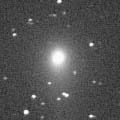
|
Although it had been rather large, well condensed, and easy to see until February, it became diffused in March. However, it keeps bright visually still now, 12.8 mag on May 4 (Seiichi Yoshida). The fading after the perihelion passage is slow, and it will keep visible at 13 mag for a while after this. In the Northern Hemisphere, it is getting lower slowly in the evening sky, but it will be higher than 20 deg still in mid August.
Date(TT) R.A. (2000) Decl. Delta r Elong. m1 Best Time(A, h)
June 11 8 38.39 64 34.3 3.465 2.962 52 14.5 20:59 (149, 33)
June 18 9 2.43 62 50.3 3.549 3.017 51 14.6 21:03 (147, 32)
|
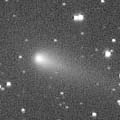
|
Although it had been strongly condensed until early January, it became diffused since late January. It had been fading gradually, around 11.5 mag in January and around 12.5 mag in February. It was still bright at 12.6 mag on Mar. 8 (Seiichi Yoshida). Although the brightness evolution before the perihelion passage was extremely rapid, the fading after the perihelion passage was slow as expected. It is already unobservable in this return.
Date(TT) R.A. (2000) Decl. Delta r Elong. m1 Best Time(A, h)
June 11 7 23.28 17 14.7 3.496 2.667 30 14.8 20:59 (112, -1)
June 18 7 35.76 16 49.9 3.570 2.699 26 14.9 21:03 (114, -5)
|

|
New bright periodic comet discovered in 2004 spring. It had been bright at 15.0-15.5 mag from spring to summer in 2004. The ephemeris says it keeps brighter than 19 mag even around the aphelion, however, the comet had not been discovered before 2004. This suggested the comet became bright temporarily last year. But actually, it keeps the same brightness in 2005, too. Now it is 14.8 mag (May 15, Akimasa Nakamura). It will be bright at 14.5 mag until autumn. However, it locates very low, around 20 deg high, in the Northern Hemisphere. So it will be hard to see it visually.
Date(TT) R.A. (2000) Decl. Delta r Elong. m1 Best Time(A, h)
June 11 20 32.24 -30 37.5 2.171 2.987 136 14.9 2:59 (356, 24)
June 18 20 30.75 -31 31.5 2.124 2.997 142 14.9 2:46 ( 0, 24)
|
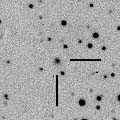
|
It brightened from 18 to 15 mag during one year from the end of 2003 to early 2005. The brightness evolution was much faster than that of a typical comet. After that, it kept 15-15.5 mag until May. It will become too low in the evening at 15 mag in June. Then it can be 13 mag and may be visible visually in next winter.
Date(TT) R.A. (2000) Decl. Delta r Elong. m1 Best Time(A, h)
June 11 6 49.08 45 47.2 6.532 5.669 29 15.0 20:59 (139, 11)
June 18 6 57.98 45 41.7 6.539 5.649 26 14.9 21:03 (141, 8)
|
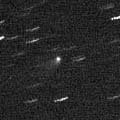
|
It was faint as 16.5 mag in early February. Then it has been brightening as expected, and reached to 15.2 mag in late April (Apr. 27, Ken-ichi Kadota). It will be observable in good condition at 14.5-15 mag until mid July. Because it locates high, it will be visible visually with a large telescope when the sky is clear. It was observed visually at 15.0 mag on May 7 (Shigeki Murakami). It brightened furthermore by 1 mag, 14.1 mag on June 13 by CCD observation (Yusuke Ezaki).
Date(TT) R.A. (2000) Decl. Delta r Elong. m1 Best Time(A, h)
June 11 15 22.13 17 22.0 2.656 3.407 130 14.9 22:01 ( 0, 72)
June 18 15 5.51 17 22.9 2.736 3.403 123 15.0 21:17 ( 0, 72)
|

|
It brightened rapidly from 19 to 17 mag in early 2004. But it is in normal state now, brightening gradually. It keeps 15-16 mag for a long time until early 2007. Although it does not locate very high in the Northern Hemisphere, it is also visible visually. Visual brightness is 14.3 mag on May 7 (Juan Jose Gonzalez) and 14.2 mag on June 7 (John Drummond), very small with a diameter of 0.2-0.6 arcmin.
Date(TT) R.A. (2000) Decl. Delta r Elong. m1 Best Time(A, h)
June 11 15 29.52 -19 48.6 2.232 3.180 154 15.1 22:09 ( 0, 35)
June 18 15 25.75 -19 51.6 2.267 3.170 147 15.1 21:38 ( 0, 35)
|

|
Peculiar asteroid moving along the orbit like a short periodic comet. It passes close by the earth from May to June, and reaches to 14 mag. In the Northern Hemisphere, it is not observable in May. But it moves northwards rapidly, and becomes observable after the beginning of June. However, it fades out very rapidly. It fades down to 15.5 mag in mid June when it becomes high, and 17 mag at the end of June. So it is only the chance to observe it in early June. On the other hand, it keeps locating high from May to June in the Southern Hemisphere. If this object is a comet actually, it may become much brighter than this ephemeris. But it was so faint as 18.5 mag in early April when it passed the perihelion, which suggests this object is indeed an asteroid. It is getting brighter rapidly now, already 15.5 mag on May 22. It was not visible, fainter than 14.0 mag on June 6 (Seiichi Yoshida). Michael Mattiazzo reported that it was completely stellar on May 29.
Date(TT) R.A. (2000) Decl. Delta r Elong. m1 Best Time(A, h)
June 11 15 52.55 -14 1.6 0.400 1.394 158 15.1 22:32 ( 0, 42)
June 18 15 46.48 -2 55.6 0.495 1.448 144 15.9 21:59 ( 0, 53)
|

|
It reached to 13 mag and was observed visually in good condition in 2004 autumn. Then it has been fading on and on while being apart from the earth. It will be low in the evening sky at 16.5 mag in August. It will be observable again in 2006, at 16.5 mag from March to April, then it will go away. Next return is in 2018, when it will be 14.3 mag at best.
Date(TT) R.A. (2000) Decl. Delta r Elong. m1 Best Time(A, h)
June 11 8 52.85 49 20.9 2.912 2.381 49 16.0 20:59 (131, 31)
June 18 9 11.59 47 15.7 2.992 2.418 47 16.0 21:03 (130, 28)
|

|
Recovery of a peculiar asteroid 2004 FS101 discovered in 2004 spring. Although it was 18 mag in mid January, it brightened to 16-16.5 mag in mid May. The brightness evolution was rather faster than that of a typical comet. It will be 14.5 mag around 2006 January, although it will be rather low for the northern observers. It keeps observable at 15-16 mag for a long time from 2005 spring to the end of 2006. Because it moves in the northern sky, it keeps observable for a long time in the Northern Hemisphere.
Date(TT) R.A. (2000) Decl. Delta r Elong. m1 Best Time(A, h)
June 11 13 16.41 50 0.5 3.893 4.018 89 16.1 20:59 (147, 71)
June 18 13 13.02 50 0.4 3.936 3.980 85 16.1 21:03 (138, 67)
|

|
Moving northwards. It will locate high in the Northern Hemisphere after this. It will be observable in good condition at 15.5 mag from July to November. Maybe it will be visible visually.
Date(TT) R.A. (2000) Decl. Delta r Elong. m1 Best Time(A, h)
June 11 0 32.61 -3 20.4 1.634 1.670 74 16.5 2:59 (288, 19)
June 18 0 49.31 -0 34.8 1.564 1.642 75 16.3 2:58 (288, 23)
|

|
It will be 16.5 mag both in 2005 summer and 2006 summer. It moves southwards, so the condition in the Northern Hemisphere is better in 2005.
Date(TT) R.A. (2000) Decl. Delta r Elong. m1 Best Time(A, h)
June 11 17 14.64 63 27.0 3.787 3.980 93 16.9 23:53 (180, 62)
June 18 17 4.13 62 19.9 3.758 3.958 93 16.8 23:15 (180, 63)
|
|
![]()
 72P/Denning-Fujikawa
72P/Denning-Fujikawa 32P/Comas Sola
32P/Comas Sola C/2005 E2 ( McNaught )
C/2005 E2 ( McNaught ) 10P/Tempel 2
10P/Tempel 2 C/2004 Q1 ( Tucker )
C/2004 Q1 ( Tucker ) 78P/Gehrels 2
78P/Gehrels 2 P/2004 F3 ( NEAT )
P/2004 F3 ( NEAT ) C/2003 WT42 ( LINEAR )
C/2003 WT42 ( LINEAR ) C/2004 K1 ( Catalina )
C/2004 K1 ( Catalina ) 117P/Helin-Roman-Alu 1
117P/Helin-Roman-Alu 1 2004 YZ23
2004 YZ23 (944) Hidalgo
(944) Hidalgo C/2005 B1 ( Christensen )
C/2005 B1 ( Christensen ) P/2005 K3 ( McNaught )
P/2005 K3 ( McNaught ) C/2005 K1 ( Skiff )
C/2005 K1 ( Skiff )![]()




















